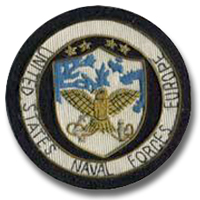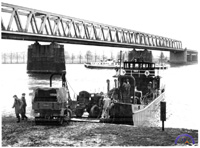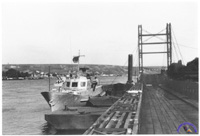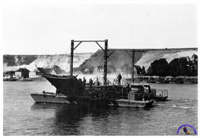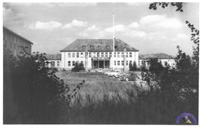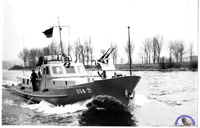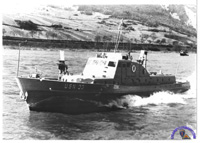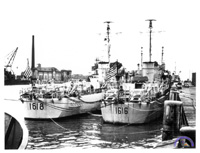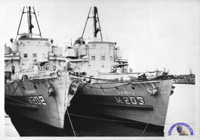US Naval Forces, Germany |
||||||||||||||||
|
|
||||||||||||||||
|
||||||||||||||||
|
|
||||||||||||||||
| U.S. Naval Forces, Germany | ||||||||||||||||
| (Source: US Naval Forces Germany Administrative History Note, National Archives) | ||||||||||||||||
| The U.S. Naval Forces, Germany was established on December 15, 1944, and to it were transferred the functions of the predecessor U.S. Naval Forces, France. Vice Admiral Robert L. Ghormley was appointed Commander U.S. Naval Forces, Germany (ComNavForGer). Its main headquarters was at Rosneath, Scotland until July 3, 1945, when it moved to Frankfurt am Main, Germany; rear headquarters at London performed routine logistics, administration, and operations. The command was under the administrative and logistic control of the U.S. Naval Forces, Europe, operating as Task Force 124 of the Twelfth Fleet. For the first two weeks of its existence it was under the operational control of the Supreme Allied Commander and the Allied Naval Commander Expeditionary Force. Upon the dissolution of SHAEF on July 14, 1945, U.S. Naval Forces, Germany was put under the operational control of the Commanding General U.S. Forces, European Theater. Under this command the Commander U.S. Naval Forces, Germany, had operational control over all naval forces on the Continent assigned to occupation duties or to the support of the U.S. Army in the European Theater of Operations. The duties of the command included supervising the disposition of captured and surrendered enemy naval personnel, clearing port areas for incoming shipping, and operating shipyards and repair facilities for the repair of German and Allied ships. The U.S. Naval Forces, Germany, was disestablished on June 20, 1957. |
||||||||||||||||
| (Source: STARS & STRIPES, April 22, 1951) | ||||||||||||||||
|
||||||||||||||||
| Originally, the mission of the US Navy in Occupation Germany was purely administrative - it was responsible for overseeing the parcelling of Germany's naval and merchant marine assets among the victorious allies. Once that mission was completed, plans called for closing out all of the Navy units in Germany. Gen Lucius D. Clay (EUCOM CG at the time) and Rear Adm Wilkes (who had arrived in July 1948 to assume his current assignment) convinced Washington to keep some naval forces in Germany. |
||||||||||||||||
|
||||||||||||||||
| (Webmaster Note: The organizational chart on the left is from the Command Report EUCOM-USAREUR from 1952 and shows the organization of USNAVGER at the end of 1952.) | ||||||||||||||||
| (Source: STARS & STRIPES, July 26, 1954) | ||||||||||||||||
| USNAVGER Higher Headquarters (Webmaster note: When the war in Europe ended in May 1945 there was a massive reduction of US naval forces in Britain. There was however, a wide dispersal of US occupation and naval forces to Germany, Italy, the south of France, and other former Axis territories. US Naval Forces in Europe (COMNAVEU), and later US Naval Forces, Eastern Atlantic and Mediterranean, exercised administrative and operational command over all US naval forces in the Atlantic and Mediterranean theatre and was responsible for US task forces, logistics support, and naval supporting operations in this theatre, 1940-1959. US Naval Forces, Eastern Atlantic and Mediterranean, was established as a command under the US Joint Chiefs of Staff on 30 Oct 1947 and gradually assumed many of the duties previously assigned to COMNAVEU, but with an expanded range. Duties included the conduct of naval operations in the Eastern Atlantic, Mediterranean, and Middle East, the support of US occupation forces in this theatre of operations, the support of US policy in these theatres, and the planning of naval and air missions in the event of a general emergency in this theatre. In February 1960, CINCNELM was dissolved and the present command of Commander in Chief, US Naval Forces, Europe, (CINCUSNAVEUR) was established.) The Commander-in-Chief, US Naval Forces, Eastern Atlantic and Mediterranean (CINCNELM) in London is the senior US Navy command in Europe. It has three bosses: 1. CINCNELM operates under the directives of the Joint Chiefs of Staff and also serves as the Chief of Naval Operations' liaison in London with the British Admirality. 2, CINCNELM is directly subordinate to CINCEUR (Commander-in-Chief, US Forces in Europe). (However, the command is not a NATO command.) 3. CINCNELM is a subcommand of the US Atlantic Fleet. Commander-in-chief of the command is Adm. John H. Cassady (CINCNELM, Mach 1954 - Apr 1956). His subcommands include: |
||||||||||||||||
| US Naval Forces, Germany These forces are under the commander-in-chief of US European Command (CINCUSEUCOM) operationally, and under CINCNELM for naval administrative purposes. Its headquarters is in Heidelberg. USNAVGER provides naval advisers and liaison officers for the US High Commissioner in Germany and for the occupational forces in Austria. Two interesting activities of USNAVGER are the US Navy Advanced Base Bremerhaven and the Rhine River Patrol. |
||||||||||||||||
| Weser River Sub Command | ||||||||||||||||
| Communications Unit 8, Bremerhaven | ||||||||||||||||
| (Source: Personal memoris by Mel Prokity, Naval Advanced Base Bremerhaven) | ||||||||||||||||
|
||||||||||||||||
| Labor Service Unit | ||||||||||||||||
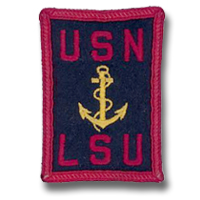 Labor Service Unit Patch Labor Service Unit Patch |
||||||||||||||||
| Labor Service Unit "C" | ||||||||||||||||
| (Source: Letter from Max Strässner, LSU "C", 1954-1965) | ||||||||||||||||
| I was a member of Labor Service Unit "C" and later the 8542nd CLG between 1954 and 1965. In hindsight, I must say that service in the LSU was much better than later under the Civilian Labor Groups. For example: the Wiesbaden Navy base (Schierstein) had a small dispensary with two doctors (one US and one German). There was a movie theater that showed a movie every night. The mess hall food was excellent with a lot of variety. Billets were large, well kept and very sanitary. Pay was very good for the 1950s. Life was good and there was a lot of comradery among the members of the LSU. So, the end of the LSU (with the transition of the RRP mission to the German Bundeswehr) seemed like the end of the world to us. After I was transferred to the CLG I did not see the same comradery. After duty hours the kaserne was empty, everybody went their own way. I have many memories from my time with the LSU and CLG - most are good, some not so great. ButI would not have missed my time with those units. A great and eventful experience. |
||||||||||||||||
|
||||||||||||||||
| Related Links: US Navy in Germany - A Yahoo Group hosted by veterans of the Rhine River Patrol, Weser River Patrol, USNAB Bremerhaven, COMNAVGER Die Flusspioniere - a reunion web site for the German Army's engineer river units. These units assumed the mission and, to some extent, the equipment of the US Navy's Rhine River Patrol, the French Forces Maritimes du Rhin (Koblenz) and the British Royal Navy Rhine Flotilla (Krefeld). Rhine River Patrol, Karlsruhe (Unit K) - a great photo page (photos provided by Ralph Rice) on Andrews Baggs' web site dedicated to the US Navy's Weser and Rhine River Patrols
Die Flusspioniere der Bundeswehr - a page on the excellent Panzerbaer.de web site. Wiesbaden-Schierstein vets might be interested at looking at the page for a nice photo of the Schierstein compound shortly after it was taken over by the German Bundeswehr. Forerunners of the West German Bundesmarine: The Klose Fast Patrol Group, the Naval Historical Team, Bremerhaven and the US Navy's Labor Service Unit (B)", Dr. Douglas Peifer, International Journal of Naval History, Vol. 1, No. 1 (online copy) Minesweeper - A very nice page; Chapter 4 - More on the Labor Service Units - especially LSU (C) which supported the Rhine River Patrol |
||||||||||||||||
